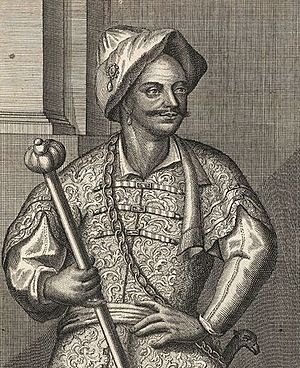Siege of Larache (1689) facts for kids
Quick facts for kids Siege of Larache |
|||||||
|---|---|---|---|---|---|---|---|
| Part of the Spanish-Moroccan conflicts | |||||||
 A view of the port of Larache in 1670. |
|||||||
|
|||||||
| Belligerents | |||||||
| Commanders and leaders | |||||||
| Strength | |||||||
| 30,000 cavalry | 2,000 soldiers 200 artillery |
||||||
| Casualties and losses | |||||||
| Unknown | 400 killed 1,700 captured 40 artillery captured 160 artillery lost |
||||||
The Siege of Larache happened in 1689. It was a big fight where the Moroccan army, led by Sultan Ismail Ibn Sharif, attacked the city of Larache. This city had been controlled by Spain for almost 80 years. After three months of fighting, the Spanish soldiers had to give up, and Morocco took back the city.
Contents
Why the Siege Happened
When Ismail Ibn Sharif became the Sultan of Morocco, he made the country very strong. He stopped rebellions and even fought against the Ottomans in Algeria.
Many cities along the coast of Morocco were controlled by European countries like Spain and Portugal. Sultan Ismail wanted to take these cities back. He had already recaptured al-Mahdya from Spain in 1681 and Tangier from the English in 1684. Next, he decided to get Larache back from the Spanish. The Spanish had built strong defenses there since 1610.
The Attack on Larache
In 1689, Sultan Ismail gathered a huge army of 30,000 horsemen to attack Larache. The Spanish had about 2,000 soldiers and 200 cannons defending the city. The Spanish knew the attack was coming, as the Sultan had told them his plans in 1688. They had spent time making the city's defenses even stronger and bringing in supplies.
Starting the Fight
The fighting began on July 14, 1689. By August, the Moroccan army had completely surrounded the city. The Moroccan forces were led by a commander named Ali ben Abdallah.
Inside the Siege
A French official in Salé, named Périllié, sent updates about the siege. On October 10, 1689, he reported that the Moroccans had two "mines" ready. These were tunnels dug under the city walls, filled with explosives. On November 6, he said the Moroccans launched a final attack. They used the exploding mines to create large holes in the city walls. This allowed them to get inside. The Spanish soldiers then retreated into the city's main fort.
The City Falls
Finally, on November 11, the Spanish troops gave up. Périllié wrote that Larache fell after the Spanish surrendered. Other reports say the main attack and capture happened on November 1.
The Spanish lost about 400 soldiers, and 1,600 or 1,700 men were captured. The Moroccans also took about 40 cannons. These cannons were later sent to Meknes.
What Happened After

After the siege, a Spanish envoy named Gaspar Gonzáles went to Meknes to talk with Sultan Ismail. He wanted to arrange for the captured Spanish governor, Fernāndo Villorias y Medrano, and 100 officers to return to Spain. The agreement was that these 100 officers and the governor could go home, but the rest of the 1,700 captured soldiers would be taken to Meknes.
However, Sultan Ismail did not follow this agreement. He also took the governor and the 100 officers to Meknes. Spain and Morocco then tried to arrange prisoner exchanges.
Prisoner Exchanges
Sultan Ismail asked for 1,000 Moroccan prisoners to be released in exchange for the Spanish officers. He said he would trade one Spanish officer for ten Moroccans.
There was also talk of exchanging 500 Moroccans and 5,000 Arabic books from the Escorial library in Spain for the officers. A Moroccan official went to Spain to check the books, but he was told that the books had burned in a fire years before. This was not true.
So, Spain had to agree to the first request: 1,000 Moroccans for 100 Spanish officers. The exchange finally happened in Ceuta in September 1691. Sultan Ismail complained that Spain only sent back old and sick Moroccans, keeping the healthy ones. Many Spanish soldiers captured in other Moroccan coastal towns were also forced to convert to Islam.
After the Siege
After taking Larache, Sultan Ismail wanted to capture Mazagan from the Portuguese. But he died in 1727 before he could do it. Mazagan was later captured by Morocco in 1769 under Sultan Mohammed III.
Larache was attacked again in 1765, this time by the French navy, but they did not succeed. Larache stayed under Moroccan control until 1911. In 1911, the Spanish took control of the city again and made it part of their protectorate in northern Morocco.
See also
 In Spanish: Asedio de Larache para niños
In Spanish: Asedio de Larache para niños
- Cession of Larache
- Larache expedition
- Siege of Melilla (1774–1775)

